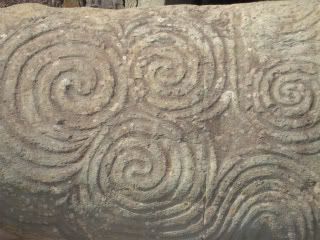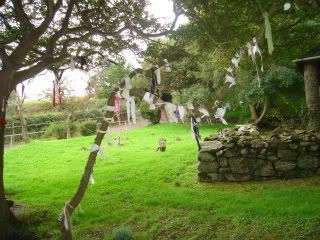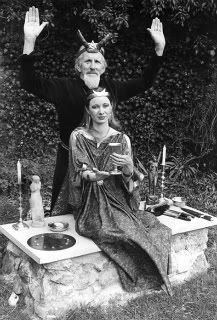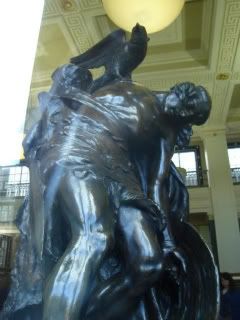"Ireland alone was never even visited, much less subjugated, by the Roman legionaries, and maintained its independence against all comers nominally until the close of the twelfth century, but for all practical purposes a good three hundred years longer
Ireland has therefore this unique feature of interest, that carried an indigenous Celtic civilisation, Celtic institutions, art, and literature, and the oldest surviving form of the Celtic language, right across the chasm which separates the antique from the modern world, the pagan from the Christian world, and on into the full light of modern history and observation."
-Thomas.W. Rolleston

A lot of this page is dedicated to all of the pagan practices, and traditions in Ireland. From the native indigenous, pre-Christian practices, Traditional paganism, occultism, neo-paganism, this island is rich with all of them.
"Pagan" is a label, and umbrella term that can be used in a variety of definitions. In Irish, Págánach is obviously a Latin loan word, used to describe the pre-Christian beliefs&practices of the island. It's a word that continues to be linked with the island to this day, found in Irish text books, literature, and tourist brochures. A brief introduction...
Said to have come to an end, at the end of the 5th century a little over a hundred years after St. Patrick's legacy of banishing the "snakes," Diarmait mac Cerbaill is said to have been the last High King of Ireland to have been inaugurated with the pagan ban feis marriage, to the Goddess of the land, ritual at Tara. The druid roles were officially said to have been completely replaced by bishops and lectors after him, as they broke down into the ranks of the poets, whose captivation on the Gaelic mind is almost frozen in time. The peaceful triumph of Christianity was able to happen because of the adoption and syncretisation the new religion was able to do with the old. Celtic Christianity was the Christianity that led the rest of Europe through the dark ages, and because of this we can actually credit the church for preserving, and recording our native traditions for us. The old beliefs of the otherworld communities remained, with the worship of the old regional patron deities simply passed down into saint veneration. Paganism has remained present in the tales of the seanchas, the many sacred sites that dot the landscape, the Irish language itself, along with traditional folk customs.

The Inquisition barely touched here, and the few recorded instances are credited to the influence of foreign clergy. Folklore of traditional witches such as Biddy Early are remnants of active paganism in a society where such people indeed considered themselves Christian, before the New Age movement.
The Irish literacy revival of the 18th century sparked a new found interest in Gaelic mythology, literature, and poetry in an archaic stance against modernism. The Neo-Druidic movement birthed from antiquarian figure heads of that time, which remains part of a roughly 300 year old tradition now. Druids in Ireland today currently maintain lineage from the likes of Druids such as George Watson MacGregor Reid. One of the main faces of the Irish Literacy Revival was William Butler Yeats, who also happened to be a member of the Hermetic Order of the Golden Dawn. Another member of this magic(k)al order, and acquaintance of Yeats, was the famed occultist, Aleister Crowley. Crowley was the head of the O.T.O in Great Britain and Ireland, that later became his Thelemic magickal order.
Because of Alexandrian Witches Janet&Stewart Farrar, Ireland was famously given its lineage to another major player responsible for introducing paganism to the public, Gerald Gardner. With the Farrar's more specific form of Alexandrian Wicca, directly handed down from Alex Sanders, Ireland gained its public introduction to the initiatory mystery tradition of Wicca.

All of the influences from these people and groups, are strongly felt in Irish paganism today in modern groves, covens, clanns, orders, e.t.c. Aside from being the "Celtic" homeland so influential in Celtic spirituality, with Ireland being the only Celtic nation in history untouched by the Roman empire, with the bulk of Celtic myths indeed being Irish, there is also a wide variety of traditions, and Gods adored on the island. The Fellowship of Isis was founded here at Clonegal Castle in 1976. Deities from Egyptian, Mesopotamian, Greek, e.t.c pantheons are all worshipped due to the growth of paganism, and neo-paganism in modern society today.

One path that I didn't give much attention to is Celtic Reconstruction Paganism. This is a scholarly path with a methodology that reconstructs historic pre-Christian Celtic practices modified for a modern context, whilst utilising sources such as the myths of native vernacular, Classical secondary accounts, archaeology, recorded folk traditions, and comparative studies with other Northern European religions. Although it shares much common ground with the attitudes of contemporary pagans in Ireland already raised with an awareness of their own culture&history , CR seems to be virtually absent here. While there are a few practitioners known to be present in the Celtic Nations, the path is most concentrated in North America for the time being.


